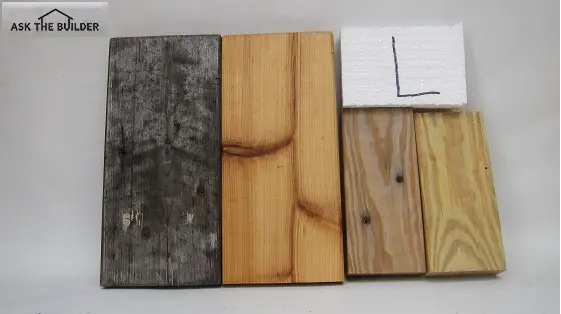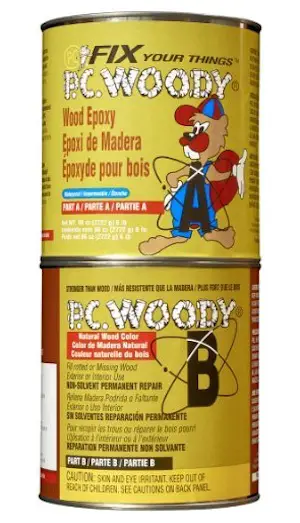Cracked Treated Wood

Can you believe this piece of treated lumber is new? It looks like a 30-year-old fishing pier. Copyright 2017 Tim Carter
Cracked Treated Wood TIPS
- Treatment chemicals evaporate causing cracks
- Seal with synthetic-resin sealers - See my test results below
- WATCH wood epoxy video series below
- Apply sealer within days of installing treated lumber
- CLICK HERE to Get Tim's FREE & FUNNY Newsletter!
DEAR TIM: Over the summer, I ripped up the old boards on my deck and replaced them with new pressure treated boards.
Now that they've had time to dry out, I'm about to stain the deck but I've discovered that a handful of boards are already splintering and cracking. This is really disappointing especially since I spent a little extra on the premium boards.
What's your advice on what I should do to remedy this? Would power washing help our just produce the same result?
Or should I replace the problem boards altogether? Should the warranty on pressure treated boards cover this? Adam W., Dallastown, PA
DEAR ADAM: Oh my, what a shame you had this happen.
Answers Abound At AsktheBuilder.com
It's so unfortunate because for years I've had the remedy at my AsktheBuilder.com website in past columns about wood deck maintenance and care.
If you would have visited my website and spent just thirty minutes researching how to care for new lumber, you'd not have this problem.
You Goofed Up
I hate to break this to you, but the entire issue was caused by you. It's very unfortunate the lumber suppliers and the store you purchased it from didn't tell you the best way to protect your investment as you left the store.
I assume they didn't.
CLICK HERE to get FREE & FAST BIDS from local companies that will seal your deck lumber.
Treated Lumber Can Be Very Wet
Here's what's going on. Treated lumber is injected with chemicals that are mixed with water.
Years ago, some of the treated lumber I worked with was so saturated with the water-based chemical brew that when you'd drive a nail into it, this liquid concoction would squirt out alongside the nail shaft as you drove the nail.
Sun & Wind Tear It Apart
As soon as you expose most treated lumber to the sun and wind by nailing it to deck joists, the liquid in the wood begins to exit to the air.
When the sun extracts this moisture out of the lumber, it creates significant tension stress within the wood fibers. Tension is the force that happens when you try to stretch, bend or pull something.
The lumber shrinks as the water leaves the wood leaving the chemicals behind that are intended to prevent the wood from rotting.
Cracks Replace The Water
This shrinkage usually causes tiny checking cracks to form. The cracks that are now filled with water take up the space previously occupied by the water that was in the wood.
These small check cracks are often about the width of a piece of paper and perhaps only an eighth of an inch long. In extreme case you can experience de-lamination along the boundaries of the summer and spring wood.
Summer wood is the dark ring you see in a log and the spring wood is the lighter-colored band.
Giant Splinters
When this de-lamination happens on flat-grained pieces of lumber, you end up with giant protruding splinters like I see in the photo you sent. There's no way to repair these.
Cracks Enlarge
Once you have cracks in the wood, you've got problems unless you stop the water from soaking into the wood. When the water soaks deeper into the wood by entering the cracks, as the sun and wind come back after the rain storm, the wood starts to shrink.
Each time this happens the tension forces usually cause the cracks to get bigger and bigger.
Pressure or Power Washing is BAD
Power washing lumber is the worst thing you can do. The high-pressure concentrated stream of water blasts away the less-dense spring wood.
What's more, it drives water deep into the cracks you already have. This is the last thing you want to happen.
Pressure Washing Video
Watch this video to see more damage caused by pressure washers.
Ground Water Vapor
To make matters worse, if your decking is close to the ground, say about 2 feet or less, water vapor coming up from the soil under the deck can damage the decking.
This water vapor causes the face of the decking on the underside of the deck to expand because water is entering the wood fibers.
On the other side, the sun and any wind is doing the opposite causing moisture to leave the wood. As we discussed, this causes the wood to shrink or get smaller.
CLICK HERE to get FREE & FAST BIDS from local companies that will seal your deck lumber.
Cupped Decking Boards
When this happens, the decking will almost always cup. This means the decking gets higher on the edges and lower in the center much like a valley between two mountains.
Seal Treated Wood Immediately
You could have avoided this costly nightmare by just staining and sealing the wood as soon as it was installed. You want the wood to be dry enough so the sealers soak in, but not so dry as the tiny checking cracks are starting to happen.
Deck Sealer Test Results
A few years ago I did an independent test on name-brand deck sealers. I took extensive before and after photos to show how well each sealer performed on treated lumber and on cedar decking.

These are four pieces of wood that were part of my extended outdoor wood sealer test. The two pieces on the left are cedar and the two smaller pieces are treated lumber. The dark gray, nearly black, piece was only out in the weather for four months. The piece to the right is what it looked like BEFORE it was put out in the sun and water!!! CLICK THIS IMAGE to get access to the full test results. Copyright 2017 Tim Carter
High-quality sealers stop water from entering treated lumber. You can often see water beading on decking that's been treated with a great sealer.
CLICK HERE to get access to my independent test of deck sealers. You'll be able to discover who won my test.
Edges & Ends
While it requires much more work and stain / sealer, it's not a bad idea to seal and stain all sides and edges of the decking before it's installed. This means you need to have a place to set out each piece to dry after you've applied the sealer.
It's best to create a drying rack in a carport or inside a garage. The last place you want to place the freshly sealed boards is out in the direct sun where they can twist and warp as they dry.
Salvage & Sand

This is a great wood epoxy that will fill larger cracks in wood decking and outdoor wood. If the wood is starting to rot, get the kit that has the PC Petrifier component. CLICK THE IMAGE NOW TO HAVE THIS PRODUCT DELIVERED TO YOUR HOME.
You may be able to salvage some of the boards that are not too bad. I'd use a belt sander with medium sandpaper to see if you can make them look presentable.
The great sealers and stains will stop water from entering tiny checking cracks so if that's all you see after sanding, I'd keep those boards.
You can use a great waterproof wood epoxy to fill large cracks. It's stainable and while it won't look exactly like the natural wood, you'll stop water from doing more damage once you seal the wood and coat the epoxy.
Any others that have large splinters or delamination will have to be replaced. Don't expect the lumber company to give you free replacements as they know you caused the issue.
You may be able to get a significant discount on your replacement boards if you talk to the lumberyard manager.
Mention that you feel they should have given you a small pamphlet about how to care for the wood. I wish you the best of luck and be sure to follow any and all directions on the labels of the sealer / stain you purchase.
Wood Epoxy Install Videos
Watch this video series to see how to use the magic wood epoxy. It's very easy and you can save lots of money and time using this product in many instances.
CLICK HERE to get FREE & FAST BIDS from local companies that will seal your deck lumber.
Column 1116
13 Responses to Cracked Treated Wood